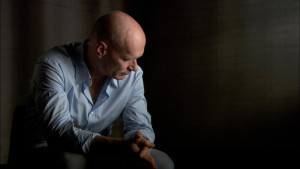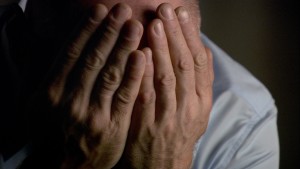 Review: Wisconsin Film Festival
Review: Wisconsin Film Festival
The Fear of 13 | David Sington | UK | 2015 | 95 minutes
Sundance Cinemas, Sunday, April 17, 4:15pm»
Barrymore Theatre, Monday, April 18, 8:15pm»
James Kreul suggests that you should see David Sington’s The Fear of 13, possibly even before reading the first sentence of this review. It’s a well crafted documentary portrait of a compelling subject, but a few structural and stylistic decisions might value storytelling over the story told.
You should see The Fear of 13, David Sington’s portrait of former death row inmate Nick Yarris. The issues I raise below are only interesting if you’ve seen it and have been moved by it. It’s a compelling film that focuses on an intriguing character and explores important topics and concepts. It’s a well crafted documentary that is not afraid to use any and all cinematic tools to inform you and affect you.
But I have some problems with this very well made film. And problems are more interesting to write about (and read about, hopefully), so here we go.
“Time…this is the strangest one” are the first words out of Nick Yarris’s mouth in The Fear of 13. While we’re supposed to contemplate the impact of 23 years on death row on Yarris’s perception of time, I couldn’t help think about the 28 years since the release of Errol Morris’s The Thin Blue Line as I watched the film. It is strange to think about the degree to which aspects of Morris’s film that were controversial in 1988—staged recreations, music, and aesthetic visual style—have been absorbed into mainstream documentary practice.
Overall this is a good thing, because widening the stylistic palette for documentary filmmakers has also broadened the range of stories explored and they manner in which they are told.
It is also possible that Morris’s lessons have been absorbed without his underlying motivations and goals. While The Fear of 13 captures many important truths, it shapes the material in a way that sometimes values the storytelling over the story told. In some ways Sington’s structural and stylistic decisions should be praised as inspired, because they certainly heighten the dramatic tension in the film. But at some point one begins to wonder if our emotional response is one conditioned by familiar storytelling tropes.
 The film opens with a sin of omission in a series of intertitles for the sake of dramatic structure and impact:
The film opens with a sin of omission in a series of intertitles for the sake of dramatic structure and impact:
“After more than two decades in Death Row convicted murderer Nick Yarris made a final petition to the Pennsylvania Courts. He requested that all appeals cease and his sentence of death be carried out. He agreed to be interviewed about this decision.”
The omission is the time difference between the second sentence and the third. Combined with visual conventions for interviews that are adhered to in the opening shots, that omission gives us a very different impression of Yarris’s interview than the understanding we have at the end of the film. The Festival programmers are willing to play along with this in the Film Guide description, using a past participle where a simple past tense verb would eliminate ambiguity. But eliminating that ambiguity would be a spoiler.
Or would it? Even I thought twice about using the word “former” in the opening sentence. But are we really living in a world where documentary films need to be protected by spoiler alerts?
I mean that question in two ways. First, are we only willing to engage in factual discourse if it can be framed as a dramatic narrative? And do we become unwilling to engage if the drama seems to be undermined by factual information revealed too soon?
Second, would knowing the time difference between those two sentences really be a spoiler? James Marsh’s Man on Wire is a good example of a film that is able to create drama and tension despite the fact that most of us know how the story ends (broadly speaking) before we start watching it.
The problem is not that I was hoodwinked, I like being hoodwinked on occasion. The problem is that Sington felt compelled to use this technique when the material was already extremely compelling. The fact that he couldn’t reveal Yarris’s current status upfront for fear that we might think the story was spoiled might say more about audiences—you know, us—than it does about Sington and other similarly compelled documentary filmmakers.
Regardless of the structure used, or what you do or don’t know going in, Nick Yarris is an incredibly compelling and intriguing subject.
 Unlike The Thin Blue Line, The Fear of 13 presents only one voice and perspective as Yarris tells his story. A more audacious move might have been to go the route of Shirley Clarke’s Portrait of Jason (1967) and simply let the camera capture him and let us contemplate the degree of performance in what we see. But Sington’s cutaway recreations during Yarris’s extended monologues provide a rich cinematic experience and immerses us into Yarris’s mind.
Unlike The Thin Blue Line, The Fear of 13 presents only one voice and perspective as Yarris tells his story. A more audacious move might have been to go the route of Shirley Clarke’s Portrait of Jason (1967) and simply let the camera capture him and let us contemplate the degree of performance in what we see. But Sington’s cutaway recreations during Yarris’s extended monologues provide a rich cinematic experience and immerses us into Yarris’s mind.
Again, structural decisions are important in algning us with Yarris. As far as we know at the beginning, he’s on death row for something. Before using logos in the discussion of Yarris’s legal history later in the film, Sington and Yarris begin with ethos and pathos. Yarris tells a beautifully sad story of two inmates, Wesley and Butch, a couple who discover that they will soon be separated and sent to different facilities. Despite the threat of punishment, Wesley sings out in his cell in lament. Yarris’s vivid telling of this story, along with Sington’s visuals and layered soundtrack, persuade us of the compassion and intelligence of the storyteller. We don’t know why he’s on death row, but we like him.
It doesn’t even matter if the story is true. We quickly align with Yarris, even if we might misunderstand his current situation during the actual interview. An opening title explains, “His story has been independently verified.” But as with Jason in Portrait of Jason, I’m not sure if I even care if he’s telling the truth or his truth. This is the kind of hoodwinking I’d be fine with. He vividly recreates moments of emotional honesty.
But it is important to contrast this with Errol Morris’s overall approach to documentary filmmaking, not just his visual style. Even in Morris’s extended interview film with one subject, The Fog of War, there’s a constant questioning of what we’re being told, rather than simply taking what we hear at face value. The Fear of 13 borrows from Morris’s style, but not always his substance.